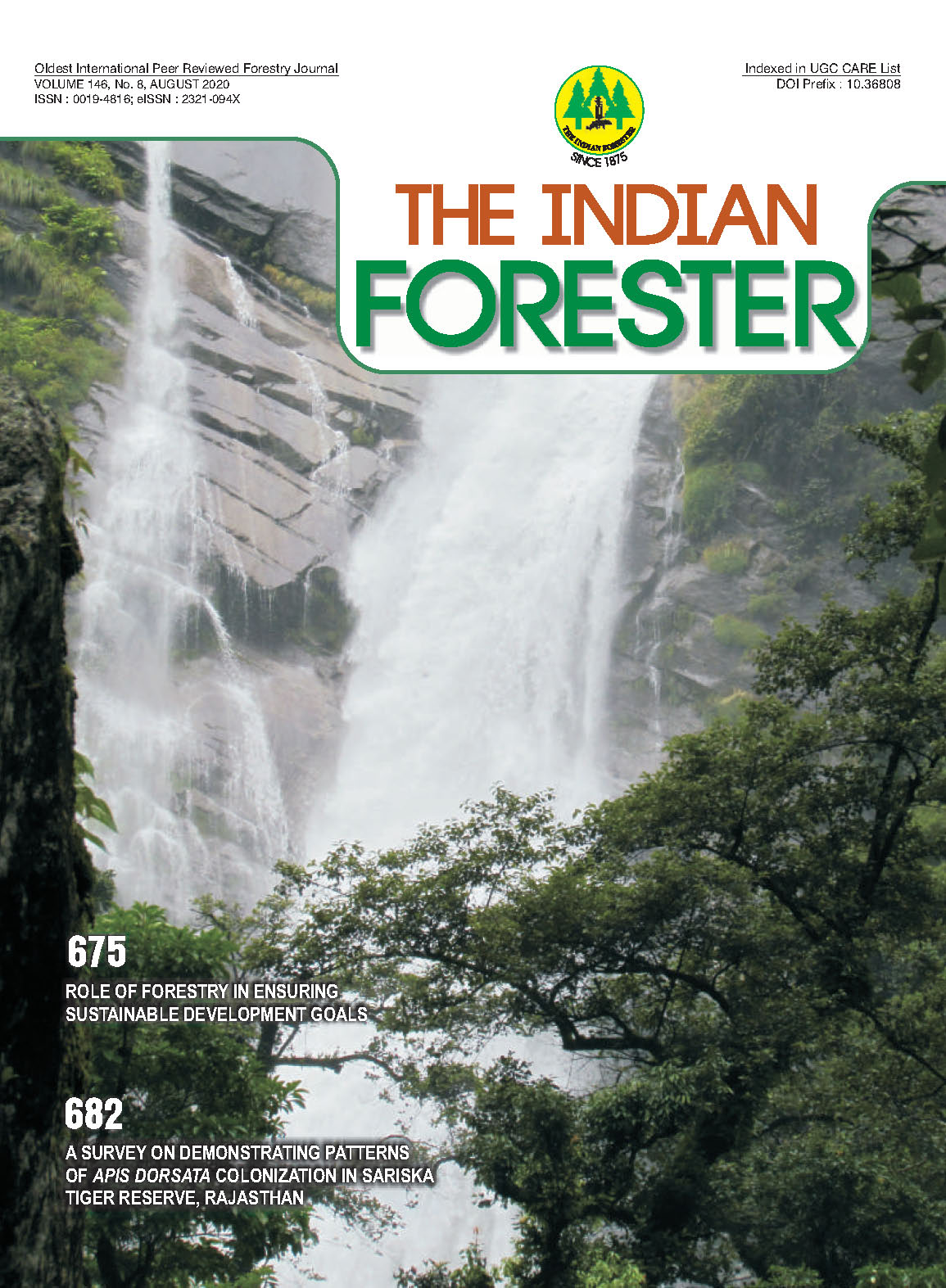Allelopathic Influence of Quercus Species on Performance of Traditional Food Crops of the Western Himalayan Region
DOI:
https://doi.org/10.36808/if/2020/v146i8/154852Keywords:
Allelopathy, Germination, Leaf and bark extracts. Plumule, Radicle, Small milletsAbstract
The present study was undertaken to assess the allelopathic effect of three Quercus species viz., Q. leucotrichophora, Q. floribunda and Q. serrata on germination and radicle-plumule growth of small millets (Echinochloa frumentacea, Eleusine coracana and Amaranthus caudatus) and one cereal crop wheat (Triticum aestivum) which are the major agricultural hill crops through laboratory bioassay. The aqueous extracts were prepared from the leaf and bark of the selected Quercus species and diluted to get 10, 25, 50, 75 and 100% concentrations. When increasing concentrations of leaf and bark extracts from 10 to 100%, it inhibited the germination and growth performance of test crops. Among the test crops, T. aestivum and E. frumentacea were found most susceptible while E. coracana and A. caudatus were the most resistant test crops. The leaf extracts were found to be more toxic in inhibiting germination and radicle-plumule growth of test crops as compared to bark extracts. The importance of these tree crops as prominent agroforestry tree species decreased in order Q. leucotrichophora < Q. floribunda < Q. serrata respectively Therefore, the results obtained within the scope of our study yielded sufficient preliminary evidence for considerable allelopathic effects from Q. floribunda and Q. serrata.References
Ahmed R., HoqueA.TM.R. and Hossain M.K. (2008). Allelopathic effects of Leucaena leucocephala leaf litter on some forest and agricultural crops grown in nursery. Journal of Forestry Research, 19(4): 298-302.
Akacha M.A.R.O.U.A., Boughanmi N.G., and Haouala R.A.B.I.A.A. (2013). Effects of Melia azedarach leaves extracts on radish growth and oxidative status. International Journal of Botany and Research, 3(2): 29-42.
Amoo S.O., Ojo A.U. and Staden J.V. (2007). Allelopathic potential of Tetrapleura tetraptera leaf extracts on early seedling growth of fiK/e agricultural crops. South African Journal ofBofeny 74:149-152.
Amoo Stephen & OjoA.U. and Staden J. (2008). Allelopathic potential of Tetrapleura tetraptera leaf extracts on early seedling growth of five agricultural crops. South African Journal of Botany 74:149-152. 10.1016/j.sajb.2007.08.010.
Bhatt B.R and Todaria N.R (1990). Studies on the allelopathic effects of some agroforestry tree crops of Garhwal Himalaya. Agroforestry systems, 12(3): 251-255.
Bhatt B.R, Chauhan D.S. and Todaria N.R (1993). Rhytotoxic effect of tree crop on germination and radicle extension of some food crop. Trop/ca/Sc/ence, 33: 69-73.
BishtA.S., Sharma K.D. and Rrasad M. (2013). Food-HortiForestry Resources of Westem Himalaya. Jaya Publishing House, 114-124.
Bogatek R., and Gniazdowska A. (2007). ROS and phytohormons in plant-plant allelopathic interaction. Plant Signaling and Behavior, 2{4y. 317-318.
Chauhan V.K. and Dhiman R.C. (2006). Response of aqueous extracts of poplar (Populus deltoides Bartr ex Marsh.) leaf on germinating wheat {Triticum aestivum L.) and maize (Zea mays L.) seeds. Indian J. Forestry, 28: 166-169.
Ding J.U., Sun Y, Xiao C.L., Shi K., Zhou Y.H. and Yu J.Q. (2007). Physiological basis of different allelopathic reactions of cucumber and figleaf gourd plants to cinnamic acid. Journal of Experimental Botany, 58(13): 3765-3773.
Hossain M.K., Dhali M.A.H. and Hossain M.S. (2002). Effects of forest soil and leaf-litter on germination and initial seedling growth of Leucaena leucocephala. Allelopathy-Journal, 10(1): 13-20.
Javed N., Ashraf M.,Akram N.A. and AlQurainy F. (2011). Alleviation of adverse effects of drought stress on growth and some potential physiological attributes in maize {Zea mays L.) by seed electromagnetic treatment. Photochemistry and Photobtotogy 87(6): 1354-1362.
Khan E.A., Khan M.A., Ahmad H.K. and Khan F.U. (2006). Allelopathic effects of eucalyptus leaf extracts on germination and growth of cotton. Ind. Cottons, 1: 96-100.
Kumar J.I.N., Sajish P.R., Kumar R.N. and Patel K. (2011). Biomass and net primary productivity in three different aged buteaforestecosystems in Westem India, Rajasthan. Iran J. Energy Environ, 2{n 1-7.
Latif A.A., Darier S.E., Razik M.A. and Salem S. (2015). Biomonitoring of allelopathy between Salix alba L. and five Triticum cultivars at Delta Region. Int J. ofAg. and Crop Sci, 8(3): 295-301.
Levin D.A., York J.R. and Billie M. (1978). The toxicity of plant alkaloids: an ecogeographic perspective Biochem. Syst ECO, 6: 61-76.
May Fiona, E. and Ash J.R (1990). An assessment of the allelopathic potential of Eucalyptus. Aust J. Botany, 38: 245-254.
Mishra A. (2015). Allelopathic properties of Lantana camara. International Research Journal of Basic and Clinical Studies, 3(1): 13-28.
NazirT, UniyalA.K. and Todaria N.R (2007). Allelopathic behaviour of three medicinal plant species on traditional agriculture crops of Garhwal Himalaya. Agrotorestry Systems, 69: 183-187.
Negi B.S., Chauhan D.S. and Todaria N.R (2007). Allelopathic effects of Ougeinia oojeinensis Roxb. (Fabaceae) on the germination and growth of wheat, barley and mustard. AlleopathyJ, 20: 403-410.
Negi S.S. and Naithani H.B. (1995). Oaks of India, Nepal and Bhutan. Dehradun: Intemational Book Distributors.
Nishimura H., Kaku K., Nakamura T, Fukazawa T and Milzutani J. (1982). Allelopathic substances (+) p- methane-3, 8-diols isolated from E. citriodnra Hook. Agr Bio. Chem, 46: 319-320.
Downloads
Downloads
Published
How to Cite
Issue
Section
License
Unless otherwise stated, copyright or similar rights in all materials presented on the site, including graphical images, are owned by Indian Forester.





